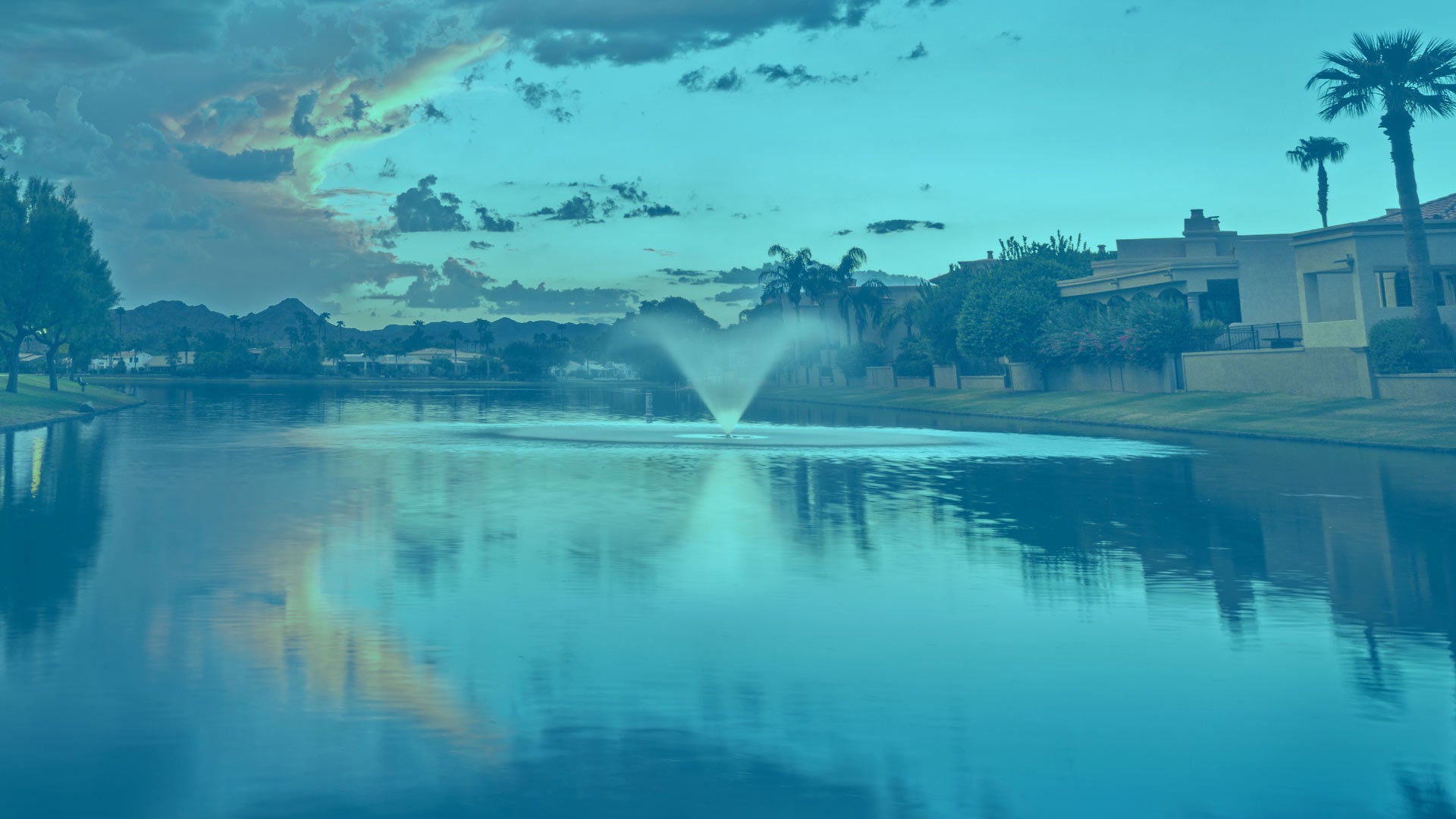Water in Motion
Pond aeration involves the natural or mechanical movement of water that breaks the pond’s surface layer, to bring the water into contact with the air, infusing oxygen into the water column.
A water aeration system will enhance the natural beauty of your pond or lake and restore water quality by creating a higher level of dissolved oxygen in a pond. Pond aerators and fountains assist Mother Nature by adding necessary oxygen in an eco-friendly yet cost and time-effective way.
So, how do you choose between a pond aerator and pond fountain? Although many variations in the types of aeration systems are available, most can be classified as either floating aerators/fountains, surface aerators, or sub-surface aerators.
Pond Fountains
Pond fountains are enjoyed by homeowners, golf courses and other commercial properties because of the beautiful spray patterns and the tranquil sound of cascading water. Our Scott Aerator Pond Fountains float on top of the water and are powered by an oil-free motor that shoots water through a variety of nozzles, creating multiple elegant patterns and a fantastic display.
Fountain light kits are often added to elevate the experience at night (see fountain lights). Fountains truly enhance the pond atmosphere and cancel out traffic noise and do turn some air into the pond. Plus, they are very good at forcing floating debris, algae, and plants like duckweed to the edges of the pond where they can be more easily removed/treated.
As far as aeration capability is concerned, a fountain will help increase oxygen into the pond, much in the same way that rainfall or wave action would. Oxygen enters a pond environment at its surface. A fountain is also pulling water from around and below it, so there is an improved circulatory affect as well. We recommend you run your fountain (or aerator) 24 hours a day, seven days a week. Our aerators can run all year or be turned off and left in the pond all winter.
In the end, most people who purchase fountains are looking for a balance between adding aeration for the pond and creating an eye-pleasing display.
Surface Aeration Or Floating Aerators
Our floating aerators keep your water sparkling clean, all while creating a mesmerizing, high-volume “white boil” effect of highly aerated water. Surface Aerators also known as pond bubblers are very functional and less geared toward aesthetics. They move a lot of water and provide an increased degree of circulation and high oxygenation into the water.
In cases of industrial facilities, often a surface aerator may be used to help settle out particulates, waste material, or discharge gases from the water. Most pond owners would not be concerned about such things, but for places that require such work, a surface aerator can be very helpful.
If you are more concerned with aeration, but still want some visual interest, the larger horsepower surface aerators do look nice especially if you add a LED light set.
Sub-Surface Aerators and Diffusers
Adding a sub-surface aeration system is the perfect way to increase your pond’s or lake’s water quality and oxygen levels while maintaining its natural appearance. Sub-surface aerators utilize diffuser modules that sit at the bottom of your pond and are connected by weighted tubing to an air compressor on shore.
The compressor pumps much-needed air to the very bottom of the pond to de-stratify the water column and infuse oxygen into the water. The membrane on the diffuser breaks the air into tiny bubbles, which are released into the pond. As these bubbles rise to the surface, they carry the low-oxygen bottom water upwards, where it mixes with the oxygen-rich surface water. The constant mixing causes the water column to de-stratify, allowing harmful gases to be released into the atmosphere.
The Bubble Pro sub-surface aerators work great as pond de-icers as well. General rule of thumb for de-icing with a diffuser: you’ll achieve a two-foot-wide circular opening for every foot of depth the diffuser is placed at. Example: if placed at a depth of one foot, the diffuser will provide an opening approximately two feet in diameter. If placed at a depth of five feet, the diffuser will achieve a 10-foot circular opening. Of course, this is an extremely general rule as temperatures will go up and down throughout the winter, and wind chills can play havoc as well.
The diffusers sit on the bottom of the pond and “diffuse” billions of bubbles which rise to the surface. The overall size of the pond determines how many diffusers you will need to adequately turn over the pond.
Diffused air not only adds oxygen into the water, it also removes the bad dissolved gasses (methane, ammonia, nitrous oxide, sulfur dioxide). As the oxygen moves out of the bubbles and into the water, these bad gases move in and are carried to the surface where they blow away on the wind. The bubbles attract water around them and lift it to the surface, exposing the nutrient rich water from the bottom to the atmosphere, releasing additional bad gases and turning in more air. These systems aid in the degradation and decomposition of organic soft sediment (muck) as they provide oxygen to the bottom sediments allowing for the bugs and microbes to consume the organic material.
- If you want to provide some aeration to your pond and desire a beautiful display at the same time, a fountain is the right choice.
- If you want the best pond management system for a healthy aquatic ecosystem with healthy, happy fish and clear water, then a surface or sub-surface diffused aerator is the better choice.
- If you want the best of both beauty and function, install a display fountain aerator — our DA-20 or North Star systems.

